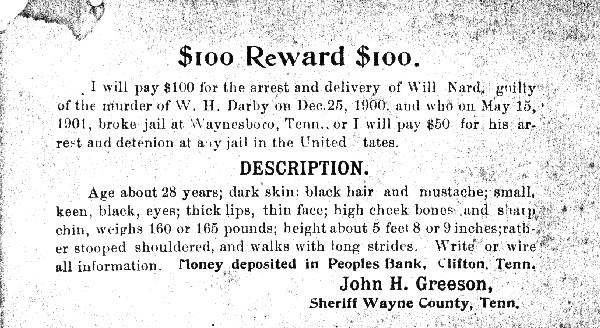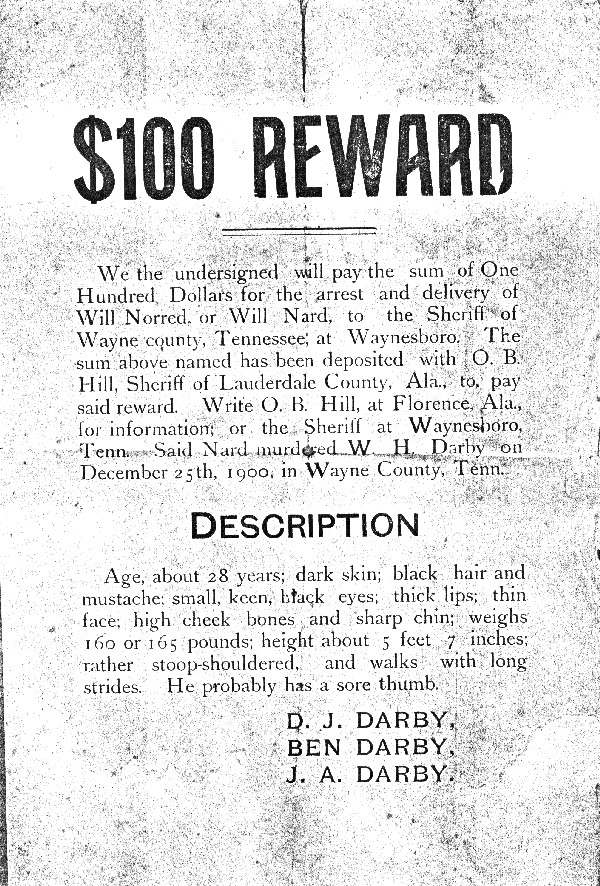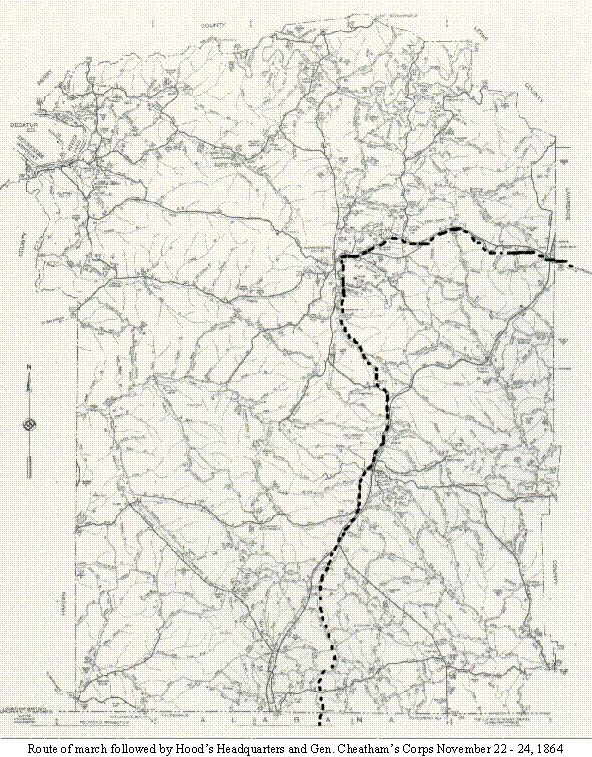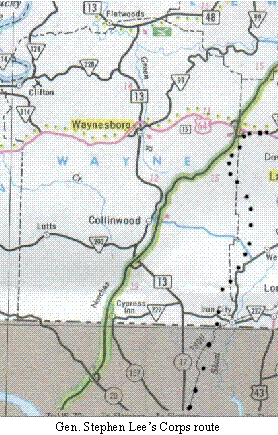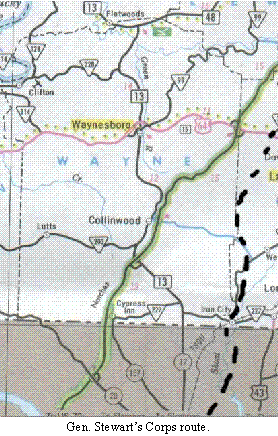By Charles M. THOMPSON. Reprinted from “The Clifton Mirror”, Clifton, Tennessee, “Anniversary Edition” of 20 October 1905.
“Some time ago the editors of the “Mirror” made a request of Mr. C. M. THOMPSON of Houston to furnish us with her early reminiscences of the early history of Wayne County. Mr. THOMPSON replied with an installment which we published several weeks ago when we published his life sketch. In this second [editor’s note: actually first installment] installment he deals with the early settlers. All Wayne County people in particular will find this article exceedingly interesting. The contribution follows:
Editor’s Mirror,
By your request I will give you now some of the early settlers of Rain’s Creek (now known as Indian Creek).
My father, Zachariah THOMPSON, Jesse CYPERT, and John CYPERT came to Wayne County in the year 1818 together with Francis CYPERT, their father and also the grandfather of the undersigned. Robert CYPERT, a brother of Francis, and a soldier in the war of 1776, came with the above and all settled on Indian Creek.
My father settled the place where Joseph SIMS (the son-in-law of J. N. DAVIS) now lives. This farm has never passed from the connection. Robt. CYPERT, the old soldier, built the first mill on Indian Creek. It was built on the George WHITE farm, a few hundred yards southwest of the corner of J. N. DAVIS’ land and was a failure. The old man then moved up the Creek about seven or eight miles and built a mill on what is known as Johnson’s Fork of Indian Creek, near the place where the Martins Mills now stands. This mill went into the hands of Willoughby PUGH, from PUGH to Samuel COOPER, from COOPER to Archibald WALKER, from WALKER to the CROMWELLS, from the CROMWELLS to the MARTINS, the present owners.
Soon after the CYPERTs came to Indian Creek, Isaac HORTON, an old soldier of the war of 1776, and his three sons, Isaac, Nathaniel and William came to Indian Creek and settled just below the old mill. It might be of interest to record the sons of Jesse, Baker and John CYPERT.
Jesse CYPERT had seven sons. John L. was a Baptist minister (correction: preacher) and was one of the organizers of the Indian Creek Association. Zachariah, William C., James, Thomas P., Robert Jasper and Jesse N. CYPERT. The latter is the only member of the family now living. He resides in Searcy, White County, Arkansas. He served one term as judge of his county. Baker CYPERT had only one son. His name was Samuel and he now resides in the State of Oregon. John CYPERT had six sons, Jesse, Robert, Anderson, Thomas J., John W., and James W. CYPERT. Thomas J. CYPERT was captain of a company in the Federal Army, served in the Legislature of Tennessee two terms as Senator, was assessor of Internal Revenue for the sixth collection district of Tennessee and was a preacher for several years before his death. His brother John was a Captain in the Confederate Army in Arkansas. The members of this family have all passed over the river.
Henry RAYBURN came to the county a little later than the CYPERTs and settled near the mouth of Rayburn Creek, where it empties into Indian creek thence its name.”
C. M. THOMPSON, Martins Mills, Tennessee.
Second Installment, published in “The Clifton Mirror”, 10 November 1905, page 8.
“Inasmuch as my last article missed the waste basket, I will come again. In my former contribution I mentioned Henry RAYBOURNE as being one of the early settlers of this county. It might be well enough to give a short sketch of him and his family.
“Squire RAYBOURNE served for years as justice of the peace for his civil district. He had four sons and three daughters. His oldest son, Gen. John RAYBOURNE was a very prominent man in the county. He was sheriff for a number of terms, surveyor and a state senator. The names of the other three sons were Samuel, Davidson, and Elihu. The latter died young and never married. Squire RAYBOURNE was the grandfather of John A. SMITH and his sister Tennie, who live near Old Town in Hardin County; he was the grandfather of Charley SMITH of Cerro Gordo and of Mrs. Joseph HARRISON living near Saltillo. The two old people, son, daughter and infant are buried in the old apple orchard near the old home.
“Thos. BROOKS settled at an early day and the farm remained in the family for several years. It then passed to Wm. PARKER, father of John Y. PARKER and an uncle of your townsman, C. C. STRIBLING. John Y. PARKER now owns and lives on this farm.
“About a mile above the creek Andrew DOWNING settled. He came with three son: John, William and Jonathan to Indian Creek about the same time BROOKS did. John DOWNING settled across the creek at the place N. W. BRATCHER now lives. Wm. DOWNING, I think, went further down the creek, perhaps in Hardin County. Jonathan remained on the old homestead until about 1860-61 and moved to West Tennessee. After the war, R. J. CYPERT bought him out, the farm having been divided and changed hands several times. John W. MIDDLETON now lives on the Old DOWNING homestead and in the house that DOWNING built.
“The next farm on the creek above was settled by David SHULL. This farm changed hands several times. After SHULL came J. R. HUGHLING, then Col. Jacob BIFFLE (BIFFLE lived on it when the war came up) then Luther FARRIS, an uncle to Dr. Will FARRIS of your town. After FARRIS, A. F. HASSELL, after HASSELL, Daniel EATON, after EATON, James RIGHT and after RIGHT, the present owner Dr. E. R. YEISER.
“The next farm of note that I will mention is that of J. N. DAVIS. It was settled at an early date by David GALLAHER who remained on it for several years. It passed from GALLAHER to Wm. PARKER and from him to his son Frank. From Frank PARKER to Capt. David I. DICKERSON from DICKERSON to the present owner, J. N. DAVIS.
“I will now cross the creek opposite to place of the writer’s birth to the David TACKETT farm. MR. TACKETT was a large land owner. His farm has been divided and sub-divided. The names of the parties occupying the lands formerly owned by TACKETT are Samuel DAVIS, Bart LAY, Will and Marion LINDSEY, Joe ROBERSON, John ROBERSON, Thos. MARTIN, Wm. NOWLIN and Wm. SCOTT.
“This brings me to the Wm. YOUNGBLOOD farm. Mr. YOUNGBLOOD came to Indian Creek at an early date and settled the farm where his grandson Zachariah HORTON now lives. Mr. YOUNGBLOOD raised three children: Josiah, Lidda, the mother of Zachariah HORTON, and John William, the father of Joe and Mat YOUNGBLOOD.”
C. M. THOMPSON, Martins Mills, Tennessee
Third Installment, published in “The Clifton Mirror”, 24 November 1905, page 1
“Here I came again. As I started out to give a short sketch of the early settlers of this section of Wayne County, I will resume by dropped down from upper Indian to what we call lower Indian.
“Squire A. B. GANTT came to Indian creek at a very early date from Bedford County, Tenn. and bought an improvement from an old gentleman by the name of Jesse O’STEEN and settled what is now known as the GANTT farm – I think the second best farm in the county.
“Squire GANTT served several terms as justice of the peace but never held any other county office. He had three sons, L. B., W. M. and A. B. GANTT and several daughters. They have all passed away except three daughters who now reside in Texas. The farm is divided and is now owned by J. Y. PARKER and W. W. JOHNSON.
“I now cross the creek to the farm where Daniel EATON lives. It was settled at an early date by Phillip CANARD who did not live but a few years. His widow remained on the farm until her death. After that it passed to Mr. HERNDON. From HERNDON to J. and E. B. MARTIN, and from MARTIN to the present owner, Daniel EATON.
“I will now cross the creek to the farm settled by George HAWK. It passed from HAWK to David COOK, a great-uncle to your townsman, Dr. COOK. After COOK it passed to Wm. J. STRAYHORN (Mr. STRAYHORN was a very prominent and influential man in this neighborhood). After STRAYHORN to Ledford NEIGHBORS and thence to the present owner, Samuel H. SINCLAIR.
“I see in the last issue an extract from a letter written by Dr. Wm. T. CHILDRESS of Terrel, Texas. He resided just across the creek south of the S. H. SINCLAIR farm and practiced medicine for ten or twelve years. Dr. CHILDRESS is well known in this neighborhood and a man who stood high in his profession.
“I will not give a short sketch of John COOK. He came to Indian Creek at an early date and settled on the farm adjoining Daniel EATON on the West side and lying in the fork of Indian and Weatherford Creeks. Mr. COOK had four sons: David, Martin, Christian and John COOK. The latter is said to have obtained the first marriage license issued in Wayne County. His bride was a Miss MARTIN, a sister of the late John A. MARTIN of Martin’s Mills. Mr. COOK was a German by birth and a hatter by trade. He was the great-grandfather of your townsman, Dr. COOK, and the grandfather of H. C. GREESON. Mr. COOK also had three sons by his second wife: Austin, Henry, and Frederick. The latter lives just across the line in Hardin County, on a portion of the land formerly owned by Hugh McCARN.
C. M. THOMPSON, Martins Mills, Tennessee
Fourth Installment, published in “The Clifton Mirror” 22 December 1905.
Mr. C. M. THOMPSON of Martin’s Mills who has been contributing a series of articles to the Mirror on the early settlers of Wayne County continues his histories sketch with the following communication:
“Editors Mirror
“Since my last article found a place on your front page, it is a pleasant inducement for me to write again.
“Continuing a sketch of the early settlers of Indian Creek, I wish to say that Messrs. Frederick ROSE, William BECKHAM and Green BECKHAM came to Indian Creek with or about the time John COOK did. Rose settled the farm across the creek north of the Daniel EATON farm. He had four sons, William, Phillips, Eli and Eanis. All settled in the same neighborhood together with William and Green BECKHAM. The former was the father of Zachariah BECKHAM, who raised twenty-one children to be men and women – fifteen sons and six daughters and all had families. Mr. BECKHAM was married three times.
“I will now pass up Weatherford Fork of Indian Creek, to the farm now known as the John SINCLAIR farm. It was settled by Stephen STUBBLEFIELD about the year 1819 or 20 and passed from STUBBLEFIELD to John SINCLAIR, (father of S. H. SINCLAIR of your town) about the year 1830, and has remained in the family to the present time.
“The above farm adjoining the latter on the south was settled by James SMITH at an early date. It passed from SMITH to William SINCLAIR, a brother of John, and remaind in the family until two or three years ago when it passed to the present owner, Jack BREWER.
“Douglass GILLIS, a Methodist preacher, settled the farm just across the creek, west from the latter and built the first camp ground that was built in this section of the county. Mr. GILLIS sold out to the SINCLAIR’s and mvoed to Horse in Hardin County, where he remained until his death.
“Jas. COPELAND, a brother-in-law of Mr. GILLIS, came to Weatherford’s Fork about the same time GILLIS did and settled the farm adjoining the above. COPELAND had five sons and one daughter. The names of the sons are Thomas S., Daniel G., James D., William and Joseph M. COPELAND. The latter is the grandfather of your townsman, Elihu DAVIS. The COPELAND farm is now owned by J. B. COPELAND, a grandson of the old man, having never massed out of the family.
“I now come to the Pinhook farm as it was known. This farm was settled by William Weatherford (thus the name of the creek) about the year 1818-1819 and was the first settled on the creek. Weatherford was part Indian and claimed to be related to Old Chief WEATHERFORD. He had four sons, Joel, Hill, John and William. The latter died young and never married. The farm passed to the Rev. W. P. KINDRICK.
“Mr. KINDRICK possessed considerable wealth and was above the average ability. He was a fine pulpit and stump orator and was a candidate for Congress at one time being defeated by the Hon. Barkley MARTIN. KINDRICK had three sons, W. P., James, and Clay. The latter died in the Confederate Army and was never married. The first son, W. P. Jr. was a very prominent man and served one term as State Senator and ranked high as an orator. He ran for Congress and was defeated by the Hon. John V. WRIGHT. Mr. KINDRICK was captured while organizing a regiment for the Federal Army and was sent to Libby Prison, and was one of the men who escaped through a tunnel and returned to Clifton. He died soon afterward and was buried in his own garden in Waynesboro, now owned by John F. MORRISON, attorney-at-law.
“James KINDRICK made his home at Florence, Alabama, and represented his county in the state legislature. Rev. Wm. P. KINDRICK was the grandfather of Dr. James BARLOW of Savannah. His wife was a sister of Judge CLAY of Alabama and also a cousin of the great statesman, orator, and politician Henry CLAY of Kentucky. The KINDRICK family have all passed away.
“I will in the near future have something more to say about the early settlers of the Pinhook neighborhood provided it is agreeable with the editor.”
Mirror Editor’s note: “Come ahead, Uncle Charlie, our space is at your disposal. Your article this week is exceedingly interesting and we are sure our Wayne County readers in particular will enjoy it. Ed.”
Fifth Installment, published in “The Clifton Mirror”, 12 January 1906, page 1.
“As I stated in my last communication that I would have something to say concerning a few more of the old settlers in the Pinhook Community and having been granted the permission of the editor to continue this series of articles, I will do so by stating that Gregory SINCLAIR, a brother to John and William SINCLAIR, bought land from Pryor YATES and settled the Pinhook farm, SINCLAIR living on this farm for several years and accumulating considerable property, both real and personal, but concluded that he could do better out west, so he sold to his nephew, William SINCLAIR, a son of John SINCLAIR, who remained on the farm until his death. His widow still occupies the old homestead.
“William SINCLAIR, Jr., was a very prominent man in his neighborhood and was a man of more than the ordinary talent. He served as Justice of the Peace for several years and ranked high as a gentleman, socially, religiously, and masonically.
“The farm adjoining the latter on the south was owned by Richard MOORE (Uncle Dickey), the father of Mastin MOORE of Hardin County and Thos. MOORE of Hardin’s Creek, the father of Richard and Ed MOORE and also the uncle of Dr. K. L. COOK of Clifton.
“The SINCLAIR family, John, William and Gregory, together with their father and two sisters came from Ireland to N.C., thence to Wayne County, Tennessee. John was a horse doctor, William a blacksmith, and Gregory, a weaver.
“The farm adjoining the Pinhook on the East at the mouth of Bear Creek was owned for several years by Benjamin WATKINS, but was sold to Wm. SINCLAIR, Sr. and remained in the family until the old man’s death. Since that time it has changed hands several time. The present owners are John HOUSE and the widow of John D. STRICKLIN.
“The farm adjoining the latter was owned at an early date by Rev. Wm. BAKER, the grandfather of Thos. J. GILLIS, living just across the line in Hardin County. BAKER sold to James A. LAWSON. The farm on the east of this was owned at a very early date by Robert SIMS, the grandfather of Robt. M. SIMS, attorney-at-law, Clifton, and also the grandfather of Thetis SIMS of Linden, the present member of Congress from the 8th district. Mr. SIMS had four sons, M. J., Robert, G. W. (father of Thetis), and A. M. (father of your townsman). SIMS sold to James A. LAWSON.
“The farm adjoining the latter on the east was settled by Nathaniel MARIN [editor’s note – surname probably MARTIN), and passed to Wm. SINCLAIR, Sr., and after him to James A. LAWSON.
“Next comes the farm settled by A. J. MARTIN, which remained in the family until about a year ago when it passed to James M. LAWSON, a grandson of James A. LAWSON.
“The next farm was settled by John N. GILLIS and passed to James A. LAWSON. LAWSON was a large land owner. He had four sons, Samuel, G. W., Thos. J., and John M. LAWSON. They are all living but the latter, and occupy the farms purchased by their father. These farms are all on Bear Creek of Weatherford’s Fork.
“If this misses the waste basket, I will come again. Wishing the editor a happy and prosperous New Year, I am, Yours truly, C. M. THOMPSON, Martin’s Mills.”
Sixth Installment, published in “The Clifton Mirror” 16 February 1906.
“Having been some time since writing you last, I have concluded to write another short sketch of the first settlers of Wayne County.
“Mr. Ben HARDIN, a land speculator, came to the county about 1817 and settled the form now known as the Gallaher farm on Factor’s Fork of Shoal Creek where the old Notchey Trace cross’d said creek (This trace was the road Gen. JACKSON cut on his march from Nashville, Tennessee, to New Orleans, the latter part of the year 1814, just before he fought the battle that is known in history as the battle of New Orleans which occurred on the 8th day, Sunday, January 1815.) The farm is still owned by the GALLAHER heirs having never passed out of the family.
“The farm lying east and adjoining the William YOUNGBLOOD farm, spoken of in an earlier article, was settled by a Mr. James GIPSON in the year 1819 or 1820, passing from him to Elijah HARBOUR. Mr. HARBOUR had three sons, Samuel, Elisha, and Elijah, and two daughters. The two first named settled in Hardin County, Sam settled on Turkey Creek about three miles above Old Town.
“Mr. HARBOUR’s farm was divided and subdivided and finally passed out of the family. Elisha settled on Indian Creek some two miles below the line. The farm settled by HARBOUR is one of the best farms on Indian Creek, this said farm never having passed out of the family. The present owner is the great-grandfather (Ed. – he means great-granddaughter) of the original settler. She is Mrs. Minnie MARTIN and is the daughter of your townsman, Mr. S. H. SINCLAIR.
“Elijah fell heir to his father’s farm and sold it to A. B. GANT and went to Mississippi. Before being divided, this was the best farm in the neighborhood. Mr. GANT divided it between his two sons, L. B. and W. M. GANT. The latter sold his to James HORTON and S. A. KING, while L. B. GANT sold his a few years fore the war between the states to Henry L. BURKETT and went to Texas. When the war came, MR. BURKETT took his family and went South, his oldest son going into the Confederate Army.
“After the war closed they settled in Mississippi and a few years later Frank BURKETT was Grand Master of the Masonic Lodge of the State of Mississippi. Henry BURKETT came back to this state and sold his land to R. C. MARTIN and Mr. MARTIN’s daughter, Mrs. Charles BOYD, is the present owner.
“The farm adjoining the Elisha HARBOUR farm on the east in Hardin County was settled by Kenneth MURCHISON, the great-grandfather of your townsman, Dr. K. L. COOK (this is his name) Said farm passed to Hugh McCARN, who accumulated considerable wealth both real and personal. He had four sons and two daughters by his first marriage and two daughters by his last marriage. The four sons were named Neal, Daniel D., John and William. The latter married but did not live but a year or two. Neal and John emigrated to Arkansas before the war. Daniel G. still remains in this county and is the only member of the family now living so far as the writer knows.
“Mr. McCARN owned a large farm at one time, but it is all owned by other people with the exception of what is owned by Daniel G. and Thomas J. GILLIS, who is a nephew to the old man.
“I guess I had better ring out before my contribution falls into the waste basket.”
Editor’s note: The Sixth Installment was the last article of the series found. If there were other articles contributed by Charles M. THOMPSON, the issues of the newspapers have not survived and therefore the articles are lost.

